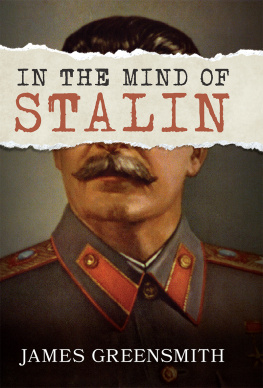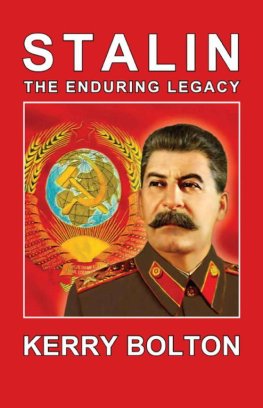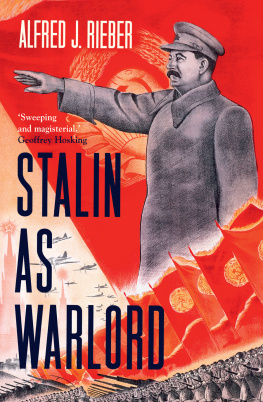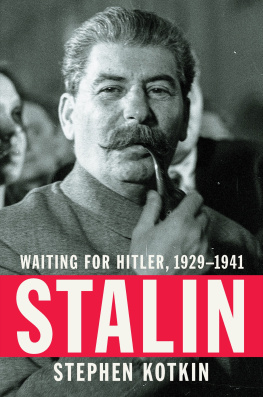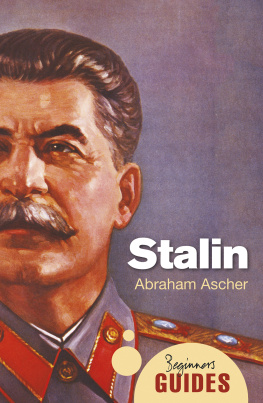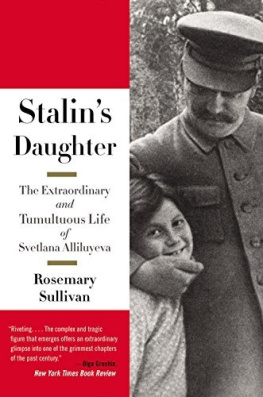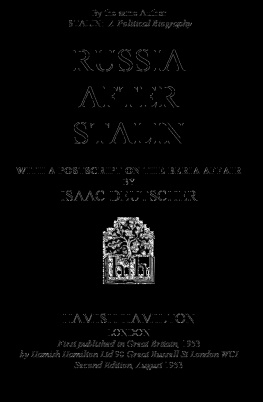Pagebreaks of the print version

IN THE MIND OF STALIN
IN THE MIND OF STALIN
JAMES GREENSMITH
First published in Great Britain in 2022 by
Pen & Sword History
An imprint of
Pen & Sword Books Ltd
Yorkshire - Philadelphia
Copyright 2022 James Greensmith
ISBN 978 1 39906 3 579
Epub ISBN 978 1 39906 3 593
Mobi ISBN 978 1 39906 3 593
The right of James Greensmith to be identified as Author of this work has been asserted by him in accordance with the Copyright, Designs and Patents Act 1988.
A CIP catalogue record for this book is available from the British Library.
All rights reserved. No part of this book may be reproduced or transmitted in any form or by any means, electronic or mechanical including photocopying, recording or by any information storage and retrieval system, without permission from the Publisher in writing.
Pen & Sword Books Ltd incorporates the Imprints of Pen & Sword Archaeology, Atlas, Aviation, Battleground, Discovery, Family History, History, Maritime, Military, Naval, Politics, Railways, Select, Transport, True Crime, Fiction, Frontline Books, Leo Cooper, Praetorian Press, Seaforth Publishing, Wharncliffe and White Owl.
For a complete list of Pen & Sword titles please contact
PEN & SWORD BOOKS LIMITED
47 Church Street, Barnsley, South Yorkshire, S70 2AS, England
E-mail:
Website: www.pen-and-sword.co.uk
Or
PEN AND SWORD BOOKS
1950 Lawrence Rd, Havertown, PA 19083, USA
E-mail:
Website: www.penandswordbooks.com
Authors Note
The following names are used in this narrative: Joseph, instead of Stalins given first name of Ioseb; Dzhugashvili for Stalins given surname. His middle name was Vissarionovich.
Stalin had many nicknames including Soso and Koba; the name Stalin first appeared in literature in January 1913.
The city of St Petersburg was renamed Petrograd in 1914, Leningrad in 1924, and St Petersburg again, in 1991. The city of Tsaritsyn was renamed Stalingrad in 1925 and Volgograd in 1961.
The Russian Social Democratic Labour Party (RSDLP) was founded in 1898. In 1903 the RSDLP split, and in early 1912 the RSDLP (Bolshevik) Party was created. In 1918 when the Bolsheviks became the ruling party of Russia, the name of the party was changed to the All-Russian Communist Party. In 1925 (after the founding of the USSR in December 1922) the Party was renamed the All-Union Communist Party (Bolsheviks). Finally, in 1952 the Party was renamed the Communist Party of the Soviet Union.
Introduction
In respect of Europe and Russia in the mid-twentieth century, two men top the gruesome list as having been responsible for the deaths of millions of people: Adolf Hitler, German Fhrer and an aggressive warmonger; and Joseph Stalin, Soviet leader who wilfully committed genocide against his own people and enforced policies such as the collectivisation of agriculture, regardless of human cost.
Hitler heard voices that no one else could hear, and it is virtually certain that he was suffering from schizophrenia. This was compounded by insanity, caused by syphilis, which affected him in his later years.
What of Stalin the name that he gave himself, from the Russian word stal, meaning Man of Steel? He was General Secretary of the Communist Party of the Soviet Union from April 1922 to October 1952 and became Soviet dictator in January 1924 after the death of Vladimir Lenin, Chairman of the Council of Peoples Commissars of the Soviet Union.
Contrary to popular belief, Stalin was capable of great tenderness and kindness, as vouched for by his daughter, Svetlana. However, when she grew to adulthood, their relationship deteriorated and her father became unkind, indifferent, and even cruel towards her.
It is impossible to quantify the total number of deaths attributable to the policies of Stalin, but the Excess Mortality (i.e., deaths over and above what would normally have been expected during the period in question) gives an approximate figure in excess of 40 million. They were murdered by the state, or died in purges in the Gulag prison system, or in famines as a direct result of agricultural collectivisation.
However, this is only part of the story of the amount of misery inflicted by the Stalin regime through torture, deliberate starvation, neglect, separation from loved ones, cold and hypothermia (e.g. in the prisons of Siberia) being unquantifiable and unimaginable.
Stalin was renowned for reacting violently to anyone whom he perceived to be a threat. But were these threats always real, or were they sometimes often even simply a figment of his imagination? In other words, was he paranoid? And if so, were his paranoid ideas his own, or was he being fed them by one or more of his henchmen who were anxious to exploit this defect in their leaders personality?
On 1 October 1939, Winston Churchill, First Lord of the Admiralty and soon to be the UKs wartime leader, described Russia as a riddle wrapped in a mystery inside an enigma. The same can certainly be said of Stalin. How can this paradox of the loving father on the one hand, and the man who sent millions to their deaths on the other, be explained?
Stalins daughter, Svetlana, confessed that she would never undertake to explain what motivated all my fathers actions, simply because I do not possess the psychological genius of [Russian novelist] Dostoevsky, who knew how to penetrate into another mans soul and examine it from within. Nonetheless, an attempt will now be made to unravel the enigma that was Stalin, and to discover what made this Man of Steel tick!
Chapter 1
Joseph Stalin (Born 18 December 1878): The Early Years: A Cherished Child
Joseph Stalin was born in Gori in eastern Georgia in 1878. Georgia, a kingdom that existed during the medieval period, was annexed by the Russian Empire in the nineteenth century. Georgia is situated between the Black Sea to the west and the Caspian Sea to the east, in a mountainous region known as the Caucasus, including Armenia and Azerbaijan to the south and parts of southern Russia to the north. A sickly child of humble origins, Joseph barely managed to survive, and yet one day he would become both famous and notorious the world over.
Josephs father, Besarion (Beso) Dzhugashvili, a Georgian of peasant stock from the village of Didi-Lilo 12 miles east of the Georgian capital, Tiflis (later named Tbilisi), was born in 1850. Besarion was a cobbler by trade, and later a worker at the Adelkhanov Shoe Factory in Tiflis.
Stalins mother, Ekaterina (Keke), was born in 1858 of a peasant serf named Geladze in the village of Gambareuli, on the outskirts of Gori. In 1935, Ekaterina wrote her memoirs, and it is therefore thanks to her that a first-hand account exists of the subject of this narrative, Joseph Stalin. Written in Georgian, the memoirs are preserved in the Archive of the Central Committee of the Communist Party of Georgia.
Ekaterina recalled her time in Gambareuli, which is where she met Besarion. They were married on 17 May 1874. and provided the family with everything. He was a kind-hearted and pious man. He attended church on Sundays. Beso was proud of me and liked taking me along when he went to church. In short, we had a happy family, [so] that a lot of people would envy us.
Besarion told Ekaterina that his ancestors had also been serfs and had come from Geri, in the Gori municipality. Our happiness had no limits, she said. But sadly, this was not to last.

